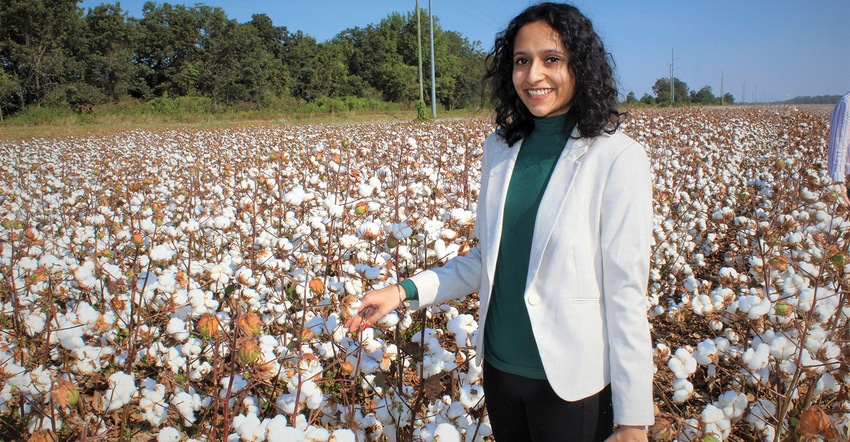
A textile executive from Punjab, India, says a recent U.S. cotton industry tour “has renewed my sense of confidence in U.S. cotton.”
Sagrika Jain, Vardhman Textiles Limited, expressed this sentiment during a recent Cotton Council International COTTON USA Tour that highlighted various segments of the U.S. cotton industry.
The tour included a visit to Mill Creek Gin, near Clarksdale, in the Mississippi Delta, where Jain and others saw firsthand how the industry protects fiber quality.
Contamination is a problem in India, she said. “We still hand harvest our cotton and there are both pros and cons to doing that. A pro would be less fiber rupture, but a con is we have much more contamination. You would be surprised to see what we find in our cotton trucked in from the fields — everything from slippers to tobacco.”
The tour group paid special attention to the round modules being unwrapped at the module feeder. “I was very interested to see how your country handles the cotton from the field until it has been ginned,” says Jain. “It was very impressive to see the care taken to not only preserve the fiber, but also to avoid contamination.”
The tour allowed her to gain a better understanding of the various U.S. cotton growths available on the world market because “…understanding cotton is to understand the roots of our yarn production,” says Jain.
Until she went on the tour, she had only read or received secondhand information about how organized and advanced the U.S. cotton industry has become. “One of the biggest takeaways from my visit is how collaborative the entire industry seems to be. It doesn’t seem internally competitive despite having so many separate business entities within the industry working to expand their individual businesses,” she said.
Jain wanted to see how those industry segments connect cotton’s flow from fields across the Cotton Belt to her mill back in India. “Cotton yarn makes up a significant percentage of our production, so cotton is obviously very important to us because it also makes up 65 percent of our costs and 80 percent of our quality,” she says.
Jain is in line to inherit the family business, Vardhman Textiles Limited, a textile yarn and fabric processing mill that turns over $1 billion dollars each year from the operation’s 1.1 million spindle yarn capacity and a 180 million meter per year woven and processed fabric division.
According to USDA’s Foreign Agriculture Service statistics, India, the second most populous nation in the world, produced over 26 million bales from more than 31 million harvested acres in 2018. Their average per-acre yield was 409 pounds. So far this year, they have purchased 447,000 bales of U.S. fiber, with roughly 200,500 of those bales already delivered. “My country produces more cotton than we consume, but we did import 1.8 million bales last year,” says Jain. “We use around 1 million bales of cotton across all of our mill operations.”
Her family’s mill uses a wide-range of cotton growths. “We import some Pima cotton, but also we have used some Memphis cottons, as well as cotton motes,” says Jain.
Ginning and textile production
All cotton produced in India is roller ginned. “The speed and capacity of production at the gin we visited today is simply amazing,” says Jain. “After our cotton is picked, it is transferred unwrapped to the ginning plants by trucks in big heaps or piles.”
Jain admits their ginning equipment is antique compared to what she saw at Mill Creek Gin. “We are a developing country, and our farms and gins rely much more on manual labor,” she says. “My family’s mill, however, has open-end and high-speed Vortex spinning capability.”
Vardhman produces more than 640 tons of yarn daily and 180 million meters of fabric annually between 22 manufacturing facilities in six states across India. “I will take home so much from this trip, but one thing in particular I’ve seen is how each part of the U.S. cotton industry always seems to be looking at the larger picture, with the ultimate goal of providing a better cotton product to their world customers,” said Jain.
About the Author(s)
You May Also Like




